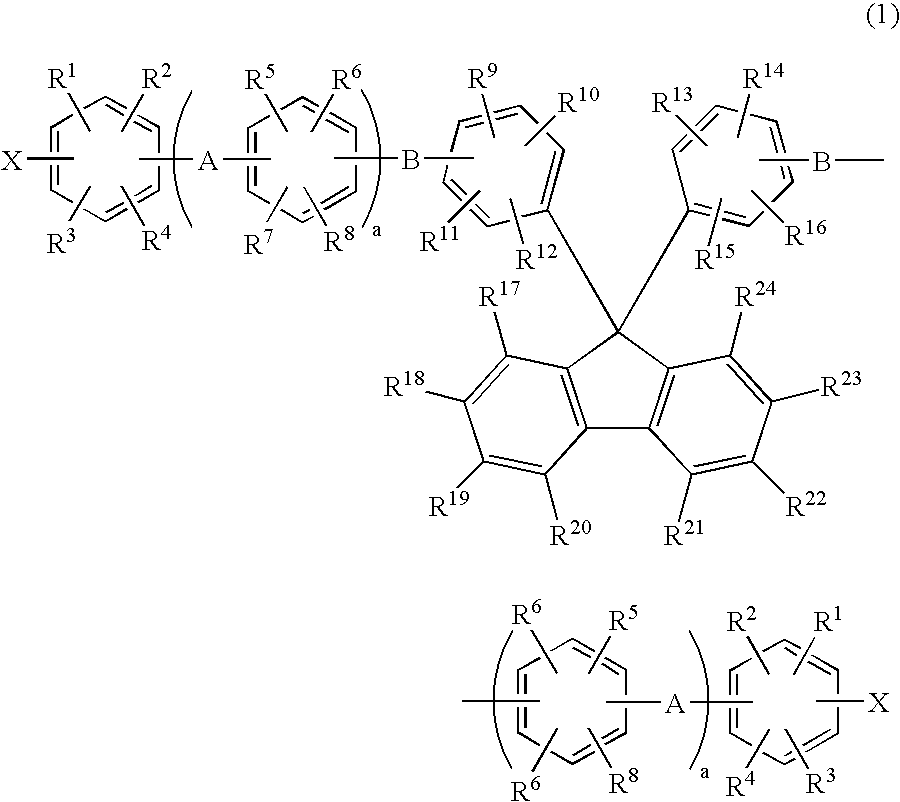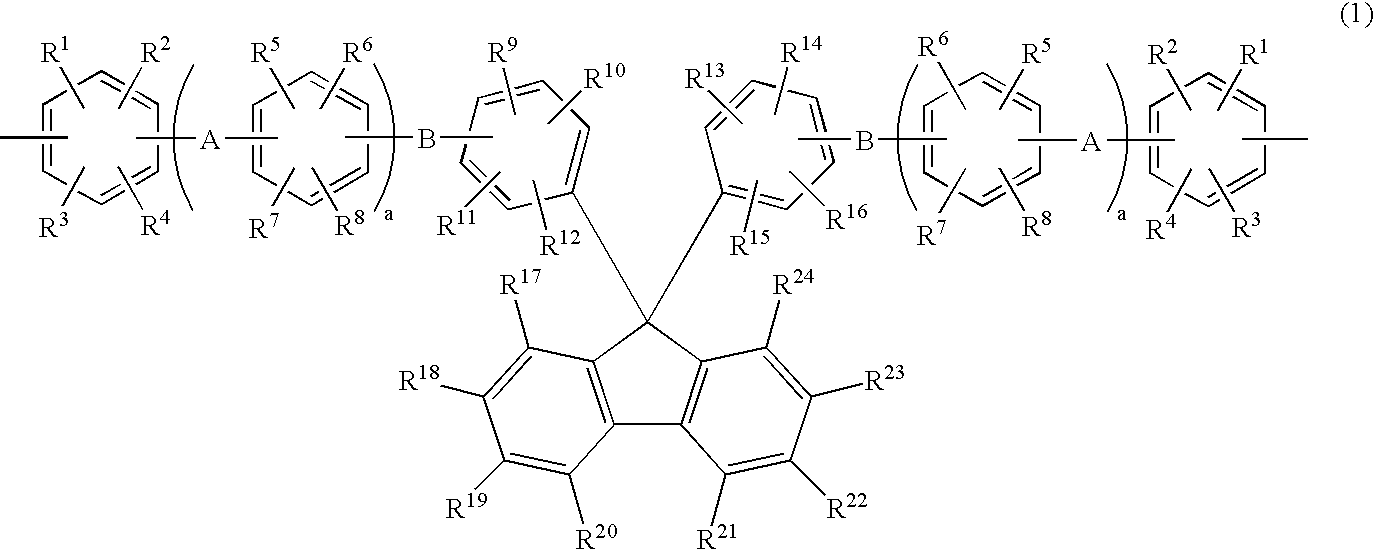Membrane-electrode assembly for solid polymer electrolyte fuel cell
a solid polymer electrolyte fuel cell and membrane electrolyte technology, applied in the direction of solid electrolyte fuel cells, fuel cells, electrochemical generators, etc., can solve the problems of insufficient proton conductivity, poor workability of proton-conductive materials formed of such inorganic compounds, and low power generation performance, so as to improve the workability and heat dissipation performance, the effect of high proton conductivity
- Summary
- Abstract
- Description
- Claims
- Application Information
AI Technical Summary
Benefits of technology
Problems solved by technology
Method used
Image
Examples
example 1
Preparation of Solid Polymer Electrolyte Membrane
[0108] Into a 1 L three-necked flask equipped with a stirrer, thermometer, Dean-Stark apparatus, nitrogen inlet, and cooling pipe were weighed 20.0 g (57 mmol) of 9,9-bisphenolfluorene, 43.1 g (171 mmol) of 2,4′-dichlorobenzophenone and 10.3 g (74 mmol) of potassium carbonate. After exchanged with nitrogen gas, 243 ml of sulfolane and 121 ml of toluene were added and stirred. The reaction liquid was heated to 130 degrees C and refluxed by use of an oil bath. Water generated through the reaction was trapped in the Dean-Stark apparatus. When water generation became near zero after three hours, toluene was removed from the Dean-Stark apparatus. The reaction temperature was gradually raised to 200 degrees C, stirring was continued for 15 hours, 43.1 g (171 mmol) of 2,4′-dichlorobenzophenone was added and allowed further to react for 8 hours.
[0109] The reaction liquid was allowed to cool and then diluted by adding 100 ml of toluene. Ino...
example 2
Preparation of Solid Polymer Electrolyte Membrane
[0118] Into a 1 L three-necked flask equipped with a stirrer, thermometer, Dean-Starkapparatus, nitrogeninlet, andcoolingpipe were weighed and added 21.6 g (57 mmol) of 9,9-biscresolfluorene, 43.1 g (171 mmol) of 4,4′-dichlorobenzophenone and 10.3 g (74 mmol) of potassium carbonate. After purging with nitrogen gas, 243 ml of sulfolane and 121 ml of toluene were added and stirred. The reaction liquid was heated to 130 degrees C and refluxed by use of an oil bath. Water generated through the reaction was trapped in the Dean-Stark apparatus. When water generation became nearly zero after three hours, toluene was removed from the Dean-Stark apparatus. The reaction temperature was gradually raised to 200 degrees C, stirring was continued for 15 hours, 43.1 g (171 mmol) of 4,4′-dichlorobenzophenone was added and allowed to further react for 8 hours.
[0119] The reaction liquid was allowed to cool and then diluted by adding 100 ml of toluen...
example 3
Preparation of Solid Polymer Electrolyte Membrane
[0124] Into a 1 L three-necked flask equipped with a stirrer, thermometer, Dean-Stark apparatus, nitrogen inlet, and cooling pipe were weighed and added 28.7 g (57 mmol) of 9,9-bis(2-phenylphenol)fluorene, 40.2 g (171 mmol) of 4-chloro-4′-fluorobenzophenone and 10.3 g (74 mmol) of potassium carbonate. After purging with nitrogen gas, 243 ml of sulfolane and 121 ml of toluene were added and stirred. The reaction liquid was heated to 130 degrees C and refluxed by use of an oil bath. Water generated through the reaction was trapped in the Dean-Stark apparatus. When water generation became nearly zero after three hours, toluene was removed from the Dean-Stark apparatus. The reaction temperature was gradually raised to 200 degrees C, stirring was continued for 15 hours, 40.2 g (171 mmol) of 4-chloro-4′-fluorobenzophenone was added and allowed further to react for 8 hours.
[0125] The reaction liquid was allowed to cool and then diluted by...
PUM
| Property | Measurement | Unit |
|---|---|---|
| ion-exchange capacity | aaaaa | aaaaa |
| ion-exchange capacity | aaaaa | aaaaa |
| ion-exchange capacity | aaaaa | aaaaa |
Abstract
Description
Claims
Application Information
 Login to View More
Login to View More - R&D
- Intellectual Property
- Life Sciences
- Materials
- Tech Scout
- Unparalleled Data Quality
- Higher Quality Content
- 60% Fewer Hallucinations
Browse by: Latest US Patents, China's latest patents, Technical Efficacy Thesaurus, Application Domain, Technology Topic, Popular Technical Reports.
© 2025 PatSnap. All rights reserved.Legal|Privacy policy|Modern Slavery Act Transparency Statement|Sitemap|About US| Contact US: help@patsnap.com



